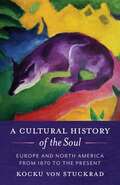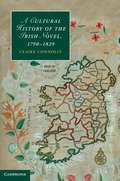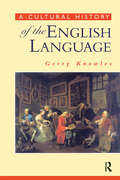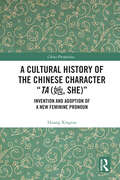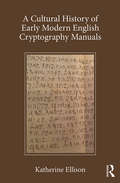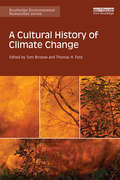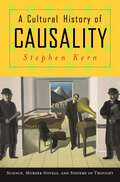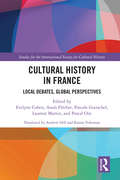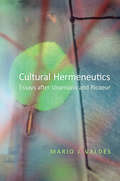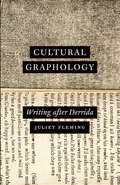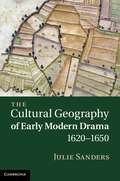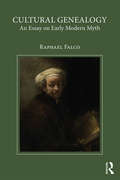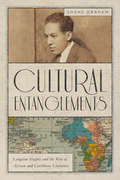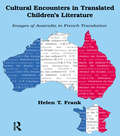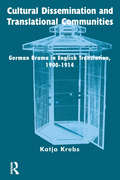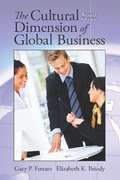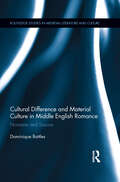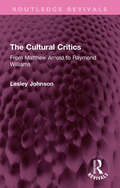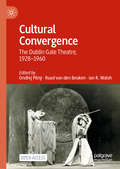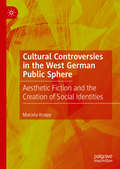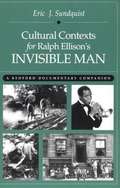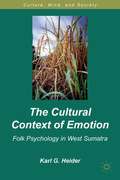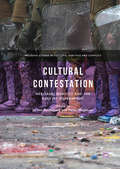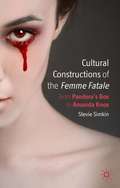- Table View
- List View
A Cultural History of Translation in Early Modern Japan
by Rebekah ClementsThe translation of texts has played a formative role in Japan's history of cultural exchange as well as the development of literature, and indigenous legal and religious systems. This is the first book of its kind, however, to offer a comprehensive survey of the role of translation in Japan during the Tokugawa period, 1600-1868. By examining a wide range of translations into Japanese from Chinese, Dutch and other European texts, as well as the translation of classical Japanese into the vernacular, Rebekah Clements reveals the circles of intellectual and political exchange that existed in early modern Japan, arguing that, contrary to popular belief, Japan's 'translation' culture did not begin in the Meiji period. Examining the 'crisis translation' of military texts in response to international threats to security in the nineteenth century, Clements also offers fresh insights into the overthrow of the Tokugawa shogunate in 1868.
A Cultural History of the Soul: Europe and North America from 1870 to the Present
by Kocku von StuckradThe soul, which dominated many intellectual debates at the beginning of the twentieth century, has virtually disappeared from the sciences and the humanities. Yet it is everywhere in popular culture—from holistic therapies and new spiritual practices to literature and film to ecological and political ideologies. Ignored by scholars, it is hiding in plain sight in a plethora of religious, psychological, environmental, and scientific movements.This book uncovers the history of the concept of the soul in twentieth-century Europe and North America. Beginning in fin de siècle Germany, Kocku von Stuckrad examines a fascination spanning philosophy, the sciences, the arts, and the study of religion, as well as occultism and spiritualism, against the backdrop of the emergence of experimental psychology. He then explores how and why the United States witnessed a flowering of ideas about the soul in popular culture and spirituality in the latter half of the century.Von Stuckrad examines an astonishingly wide range of figures and movements—ranging from Ernest Renan, Martin Buber, and Carl Gustav Jung to the Esalen Institute, deep ecology, and revivals of shamanism, animism, and paganism to Rachel Carson, Ursula K. Le Guin, and the Harry Potter franchise. Revealing how the soul remains central to a culture that is only seemingly secular, this book casts new light on the place of spirituality, religion, and metaphysics in Europe and North America today.
A Cultural History of the Irish Novel, 1790–1829
by Claire ConnollyClaire Connolly offers a cultural history of the Irish novel in the period between the radical decade of the 1790s and the gaining of Catholic Emancipation in 1829. These decades saw the emergence of a group of talented Irish writers who developed and advanced such innovative forms as the national tale and the historical novel: fictions that took Ireland as their topic and setting and which often imagined its history via domestic plots that addressed wider issues of dispossession and inheritance. Their openness to contemporary politics, as well as to recent historiography, antiquarian scholarship, poetry, song, plays and memoirs, produced a series of notable fictions; marked most of all by their ability to fashion from these resources a new vocabulary of cultural identity. This book extends and enriches the current understanding of Irish Romanticism, blending sympathetic textual analysis of the fiction with careful historical contextualization.
A Cultural History of the English Language (The English Language Series)
by Gerry KnowlesThis book presents a new interpretation of the history of English. Access to large corpuses of English has allowed scholars to assess the minutiae of linguistic change with much greater precision than before, often pinpointing the beginnings of linguistic innovations in place and time. The author uses the findings from this research to relate major historical events to change in the language, in particular to areas of linguistic inquiry that have been of particular importance in recent years, such as discourse analysis, stylistics and work on pidgins and creoles. The book does not attempt to chronicle changes in syntax or pronunciation and spelling, but is designed to complement a corpus-based study of formal changes. The story of English is brought up to the late 1990s to include, amongst other things, discussions of Estuary English and the implications of the information superhighway.
A Cultural History of the Chinese Character “Ta: Invention and Adoption of a New Feminine Pronoun (China Perspectives)
by Huang XingtaoThis book offers a thorough examination of the history of a Chinese female pronoun – the Chinese character "Ta (她, She)" and demonstrates how the invention and identification of this new word is inextricably intertwined with matters of sociocultural politics. The Chinese character Ta for the third-person feminine singular pronoun was introduced in the late 1910s when the voices of women’s liberation rang out in China. The invention and dissemination of this word not only reflected an ideological gendering of the Chinese script but also provoked heated academic and popular debate well into the 1930s. Thus, the history of Ta provides a prism through which to explore modern Chinese history. The author provides an ambitious and informed examination of how Ta was invented and promoted in relation to the gender equality movement, the politics of neologism, and other domestic elements and international catalysts. This book is the first major work to survey Ta’s creation. It draws on diverse sources, including interviews with eight historians who experienced the popularisation of Ta as youths in the 1930s and 40s. This book will be an essential read for students and scholars of East Asian Studies, Chinese Cultural History, and those who are interested in the history of China.
A Cultural History of Early Modern English Cryptography Manuals
by Katherine EllisonDuring and after the English civil wars, between 1640 and 1690, an unprecedented number of manuals teaching cryptography were published, almost all for the general public. While there are many surveys of cryptography, none pay any attention to the volume of manuals that appeared during the seventeenth century, or provide any cultural context for the appearance, design, or significance of the genre during the period. On the contrary, when the period’s cryptography writings are mentioned, they are dismissed as esoteric, impractical, and useless. Yet, as this book demonstrates, seventeenth-century cryptography manuals show us one clear beginning of the capitalization of information. In their pages, intelligence—as private message and as mental ability—becomes a central commodity in the emergence of England’s capitalist media state. Publications boasting the disclosure of secrets had long been popular, particularly for English readers with interests in the occult, but it was during these particular decades of the seventeenth century that cryptography emerged as a permanent bureaucratic function for the English government, a fashionable activity for the stylish English reader, and a respected discipline worthy of its own genre. These manuals established cryptography as a primer for intelligence, a craft able to identify and test particular mental abilities deemed "smart" and useful for England’s financial future. Through close readings of five specific primary texts that have been ignored not only in cryptography scholarship but also in early modern literary, scientific, and historical studies, this book allows us to see one origin of disciplinary division in the popular imagination and in the university, when particular broad fields—the sciences, the mechanical arts, and the liberal arts—came to be viewed as more or less profitable.
A Cultural History of Climate Change (Routledge Environmental Humanities)
by Tom Bristow Thomas H. FordCharting innovative directions in the environmental humanities, this book examines the cultural history of climate change under three broad headings: history, writing and politics. Climate change compels us to rethink many of our traditional means of historical understanding, and demands new ways of relating human knowledge, action and representations to the dimensions of geological and evolutionary time. To address these challenges, this book positions our present moment of climatic knowledge within much longer histories of climatic experience. Only in light of these histories, it argues, can we properly understand what climate means today across an array of discursive domains, from politics, literature and law to neighbourly conversation. Its chapters identify turning-points and experiments in the construction of climates and of atmospheres of sensation. They examine how contemporary ecological thought has repoliticised the representation of nature and detail vital aspects of the history and prehistory of our climatic modernity. This ground-breaking text will be of great interest to researchers and postgraduate students in environmental history, environmental governance, history of ideas and science, literature and eco-criticism, political theory, cultural theory, as well as all general readers interested in climate change.
A Cultural History of Causality: Science, Murder Novels, and Systems of Thought
by Stephen KernThis pioneering work is the first to trace how our understanding of the causes of human behavior has changed radically over the course of European and American cultural history since 1830. Focusing on the act of murder, as documented vividly by more than a hundred novels including Crime and Punishment, An American Tragedy, The Trial, and Lolita, Stephen Kern devotes each chapter of A Cultural History of Causality to examining a specific causal factor or motive for murder--ancestry, childhood, language, sexuality, emotion, mind, society, and ideology. In addition to drawing on particular novels, each chapter considers the sciences (genetics, endocrinology, physiology, neuroscience) and systems of thought (psychoanalysis, linguistics, sociology, forensic psychiatry, and existential philosophy) most germane to each causal factor or motive. Kern identifies five shifts in thinking about causality, shifts toward increasing specificity, multiplicity, complexity, probability, and uncertainty. He argues that the more researchers learned about the causes of human behavior, the more they realized how much more there was to know and how little they knew about what they thought they knew. The book closes by considering the revolutionary impact of quantum theory, which, though it influenced novelists only marginally, shattered the model of causal understanding that had dominated Western thought since the seventeenth century. Others have addressed changing ideas about causality in specific areas, but no one has tackled a broad cultural history of this concept as does Stephen Kern in this engagingly written and lucidly argued book.
Cultural History in France: Local Debates, Global Perspectives (Studies for the International Society for Cultural History)
by Evelyne Cohen Anaïs Fléchet Pascale Gœtschel Laurent Martin Pascal Ory Andrew Hill Rosine FefermanThis volume, which gathers contributions presented at the annual conferences of l'Association pour le développement de l'histoire culturelle (ADHC), questions the subjects and boundaries of cultural history in France – with regard to neighboring approaches such as cultural studies, media studies, and gender studies – to elaborate a "social history of representations." Historians, philosophers and sociologists address a large variety of topics and methodological proposals. Definitions, objects and actors, memories and cultural transfers: this book depicts the major questions that underlie the historical debate at the beginning of the 21st century.
Cultural Hermeneutics: Essays after Unamuno and Ricoeur
by Mario ValdesIn Cultural Hermeneutics, Mario J. Valdés offers a synthesis of the hermeneutic philosophies of Miguel de Unamuno and Paul Ricoeur, a dialectical method that has formed the basis for many of Valdés' own studies in comparative literature. As Valdés explains in these insightful essays, what Unamuno and Ricoeur shared in their hermeneutic studies was a theory of interpretation in which the meaning of a work of art comes into existence through the dialectical relationship between its creator and its readers, listeners, or viewers. Contextualizing this hermeneutic concept as it appears in the works of both philosophers, Cultural Hermeneutics presents the basis for a profound understanding of the arts.
Cultural Graphology: Writing after Derrida
by Juliet Fleming"Cultural Graphology" could be the name of a new human science: this was Derrida's speculation when, in the late 1960s, he imagined a discipline that combined psychoanalysis, deconstruction, and a commitment to the topic of writing. He never undertook the project himself but did leave two brief sketches of how he thought cultural graphology might proceed. In this book, Juliet Fleming picks up where Derrida left off. Using both his early and later thought, and the psychoanalytic texts to which it is addressed, to examine the print culture of early modern England, she drastically unsettles some key assumptions of book history. Fleming shows that the single most important lesson to survive from Derrida's early work is that we do not know what writing is. Channeling Derrida's thought into places it has not been seen before, she examines printed errors, spaces, and ornaments (topics that have hitherto been marginal to our accounts of print culture) and excavates the long-forgotten reading practice of cutting printed books. Proposing radical deformations to the meanings of fundamental and apparently simple terms such as "error," "letter," "surface," and "cut," Fleming opens up exciting new pathways into our understanding of writing all told.
The Cultural Geography of Early Modern Drama, 1620–1650
by Julie SandersLiterary geographies is an exciting new area of interdisciplinary research. Innovative and engaging, this book applies theories of landscape, space and place from the discipline of cultural geography within an early modern historical context. Different kinds of drama and performance are analysed: from commercial drama by key playwrights to household masques and entertainment performed by families and in semi-official contexts. Sanders provides a fresh look at works from the careers of Ben Jonson, John Milton and Richard Brome, paying attention to geographical spaces and habitats like forests, coastlines and arctic landscapes of ice and snow, as well as the more familiar locales of early modern country estates and city streets and spaces. Overall, the book encourages readers to think about geography as kinetic, embodied and physical, not least in its literary configurations, presenting a key contribution to early modern scholarship.
Cultural Genealogy: An Essay on Early Modern Myth
by Raphael FalcoCultural Genealogy explores the popularization in the Renaissance of the still pervasive myth that later cultures are the hereditary descendants of ancient or older cultures. The core of this myth is the widespread belief that a numinous charismatic power can be passed down unchanged, and in concrete forms, from earlier eras. Raphael Falco shows that such a process of descent is an impossible illusion in a knowledge-based culture. Anachronistic adoption of past values can only occur when these values are adapted and assimilated to the target culture. Without such transcultural adaptation, ancient values would appear as alien artifacts rather than as eternal truths. Scholars have long acknowledged the Renaissance borrowings from classical antiquity, but most studies of translatio studii or translatio imperii tacitly accept the early modern myth that there was a genuine translation of Greek and Roman cultural values from the ancient world to the "modern." But as Falco demonstrates, this is patently not the case. The mastering of ancient languages and the rediscovery of lost texts has masked the fact that surprisingly little of ancient religious, ethical, or political ideology was retained — so little that it is crucial to ask why these myths of transcultural descent have not been recognized and interrogated. Through examples ranging from Petrarch to Columbus, Maffeo Vegio to the Habsburgs, Falco shows how the new techne of systematic genealogy facilitated the process of "remythicizing" the ancient authorities, utterly transforming Greek and Roman values and reforging them into the mold of contemporary needs. Chiefly a study of intellectual culture, Cultural Genealogy has ramifications reaching into all levels of society, both early modern and later.
Cultural Entanglements: Langston Hughes and the Rise of African and Caribbean Literature (New World Studies)
by Shane GrahamIn addition to being a poet, fiction writer, playwright, and essayist, Langston Hughes was also a globe-trotting cosmopolitan, travel writer, translator, avid international networker, and—perhaps above all—pan-Africanist. In Cultural Entanglements, Shane Graham examines Hughes’s associations with a number of black writers from the Caribbean and Africa, exploring the implications of recognizing these multiple facets of the African American literary icon and of taking a truly transnational approach to his life, work, and influence. Graham isolates and maps Hughes’s cluster of black Atlantic relations and interprets their significance. Moving chronologically through Hughes’s career from the 1920s to the 1960s, he spotlights Jamaican poet and novelist Claude McKay, Haitian novelist and poet Jacques Roumain, French Negritude author Aimé Césaire of Martinique, South African writers Es’kia Mphahlele and Peter Abrahams, and Caribbean American novelist Paule Marshall. Taken collectively, these writers’ intellectual relationships with Hughes and with one another reveal a complex conversation—and sometimes a heated debate—happening globally throughout the twentieth century over what Africa signified and what it meant to be black in the modern world. Graham makes a truly original contribution not only to the study of Langston Hughes and African and Caribbean literatures but also to contemporary debates about cosmopolitanism, the black Atlantic, and transnational cultures.
Cultural Encounters in Translated Children's Literature
by Helen FrankCultural Encounters in Translated Children's Literature offers a detailed and innovative model of analysis for examining the complexities of translating children's literature and sheds light on the interpretive choices at work in moving texts from one culture to another. The core of the study addresses the issue of how images of a nation, locale or country are constructed in translated children's literature, with the translation of Australian children's fiction into French serving as a case study. Issues examined include the selection of books for translation, the relationship between children's books and the national and international publishing industry, the packaging of translations and the importance of titles, blurbs and covers, the linguistic and stylistic features specific to translating for children, intertextual references, the function of the translation in the target culture, didactic and pedagogical aims, euphemistic language and explicitation, and literariness in translated texts. The findings of the case study suggest that the most common constructs of Australia in French translations reveal a preponderance of traditional Eurocentric signifiers that identify Australia with the outback, the antipodes, the exotic, the wild, the unknown, the void, the end of the world, the young and innocent nation, and the Far West. Contemporary signifiers that construct Australia as urban, multicultural, Aboriginal, worldly and inharmonious are seriously under-represented. The study also shows that French translations are conventional, conservative and didactic, showing preference for an exotic rather than local specificity, with systematic manipulation of Australian referents betraying a perception of Australia as antipodean rural exoticism. The significance of the study lies in underscoring the manner in which a given culture is constructed in another cultural milieu, especially through translated children's literature.
Cultural Dissemination and Translational Communities: German Drama in English Translation 1900-1914
by Katja KrebsThe early twentieth century is widely regarded as a crucial period in British theatre history: it witnessed radical reform and change with regard to textual, conceptual and institutional practices and functions. Theatre practitioners and cultural innovators such as translators Harley Granville Barker, William Archer and Jacob Thomas Grein, amongst others, laid the foundations during this period for - what is now regarded to be - modern British theatre. In this groundbreaking work, Katja Krebs offers one of the first extended attempts to integrate translation history with theatre history by analyzing the relationship between translational practice and the development of domestic dramatic tradition. She examines the relationship between the multiple roles inhabited by these cultural and theatrical reformers - directors, playwrights, critics, actors and translators - and their positioning in a wider social and cultural context. Here, she takes into consideration the translators as members of an artistic network or community, the ideological and personal factors underlying translational choices, the contemporaneous evaluative framework within which this translational activity for the stage occurred, as well as the imprints of social and cultural traces within specific translated texts. Krebs employs the examples from this period in order to raise a series of wider issues on translating dramatic texts which are important to a variety of periods and cultures. Cultural Dissemination and Translational Communities demonstrates that an analysis of stage-translational practices allows for an understanding of theatre history that avoids being narrowly national and instead embraces an appreciation of cultural hybridity. The importance of translational activity in the construction of a domestic dramatic tradition is demonstrated within a framework of interdisciplinarity that enhances our understanding of theatrical, translational as well as cultural and social systems at the international level.
The Cultural Dimension of Global Business 7th Edition
by Gary P. Ferraro Elizabeth K. BriodyThe Cultural Dimension of Global Business provides a foundation for understanding the impact of culture on global business and global business on culture.
Cultural Difference and Material Culture in Middle English Romance: Normans and Saxons
by Dominique BattlesThis book explores how the cultural distinctions and conflicts between Anglo-Saxons and Normans originating with the Norman Conquest of 1066 prevailed well into the fourteenth century and are manifest in a significant number of Middle English romances including King Horn, Havelok the Dane, Sir Orfeo, Sir Gawain and the Green Knight, and others. Specifically, the study looks at how the material culture of these poems (architecture, battle tactic, landscapes) systematically and persistently distinguishes between Norman and Anglo-Saxon cultural identity. Additionally, it examines the influence of the English Outlaw Tradition, itself grounded in Anglo-Saxon resistance to the Norman Conquest, as expressed in specific recurring scenes (disguise and infiltration, forest exile) found in many Middle English romances. In the broadest sense, a significant number of Middle English romances, including some of the most well-read and often-taught, set up a dichotomy of two ruling houses headed by a powerful lord, who compete for power and influence. This book examines the cultural heritage behind each of these pairings to show how poets repeatedly contrast essentially Norman and Anglo-Saxon values and ruling styles.
The Cultural Critics: From Matthew Arnold to Raymond Williams (Routledge Revivals)
by Lesley JohnsonOriginally published in 1979, the central focus of this study is the concept of culture as employed by English literary intellectuals over the preceding 100 years, a period characterized by a constant process of re-definition and change. The tradition of criticism in which these intellectuals wrote represented the artistic imagination as a moral force in society and a fundamental mechanism for social change. The author traces this tradition through the writings of various English intellectuals, using the three main figures of Matthew Arnold, F. R. Leavis and Raymond Williams to elucidate the concept. She shows, through the writings of their contemporaries, how the concept was employed and modified, and her analysis ranges from J. S. Mill, John Ruskin and William Morris, through George Bernard Shaw, D. H. Lawrence, T. S. Eliot and R. H. Tawney to Richard Hoggard, Richard Wollheim and R. S. Peters. By discussing the questions of the role of art in society and examining their treatment by different groups of intellectuals, the author has supplied a basis for a forceful critique of the quality of life in modern industrial society. This book will be of interest to students of literature, cultural history and the sociology of culture.
Cultural Convergence: The Dublin Gate Theatre, 1928–1960
by Ondřej Pilný Ian R. Walsh Ruud van den BeukenBased on extensive archival research, this open access book examines the poetics and politics of the Dublin Gate Theatre (est. 1928) over the first three decades of its existence, discussing some of its remarkable productions in the comparative contexts of avant-garde theatre, Hollywood cinema, popular culture, and the development of Irish-language theatre, respectively. The overarching objective is to consider the output of the Gate in terms of cultural convergence – the dynamics of exchange, interaction, and acculturation that reveal the workings of transnational infrastructures.
Cultural Controversies in the West German Public Sphere: Aesthetic Fiction and the Creation of Social Identities
by Marcela KnappThis book develops a theory of aesthetic fiction’s impact on social identities. Throughout five case studies, the author develops the argument that social identities are nurtured by and may even emerge through the conflict between different aesthetic expressions. As it creates affective structures, narrative fiction enables the development and formation of political and cultural identities. This work is part of a field of research that deals with the aesthetics of the everyday and the idea of social aesthetics. It argues for a central role for the arts in the creation and formation of modern society. Social identities emerge in response to aesthetic-sensual patterns of perception.Focusing on five West German public debates in the years 1950 to 1990, this work sheds light upon the transformation of social reality through the discursive adaption of art.
Cultural Contexts for Ralph Ellison's Invisible Man: A Bedford Documentary Companion
by Eric J. SundquistA unique supplement to one of the most important African American novels of this century. As Invisible Man chronicles the major moments of African American life during the first half of the twentieth century, this volume illuminates and contextualizes the novel with a collection of speeches, essays, folktales, historical analyses, photographs, and other cultural and historical documents.
The Cultural Context of Emotion
by Karl G. HeiderBased on the author's second stage of research on emotions of the matrilineal Moslem Minangkabau of West Sumatra, Indonesia, this book is a continuation of Heider's groundbreaking 1991 book, Landscapes of Emotion . This work demonstrates how situating emotion at the center of an investigation is a powerful ethnographic tool.
Cultural Contestation: Heritage, Identity And The Role Of Government (Palgrave Studies In Cultural Heritage And Conflict)
by Jeroen Rodenberg Pieter WagenaarHeritage practices often lead to social exclusion, as such practices can favor certain values over others. In some cases, exclusion from a society’s symbolic landscape can spark controversy, or rouse emotion so much so that they result in cultural contestation. Examples of this abound, but few studies explicitly analyze the role of government in these instances. In this volume, scholars from a variety of academic backgrounds examine the various and often conflicting roles governments play in these processes—and governments do play a role. They act as authors and authorizers of the symbolic landscape, from which societal groups may feel excluded. Yet, they also often attempt to bring parties together and play a mitigating role.
Cultural Constructions of the Femme Fatale
by Stevie SimkinThe figure of the beautiful but lethal woman has haunted the Western imagination from ancient myth (Pandora, Eve, Lilith) to contemporary cinema. However, there are also remarkable 'real life' cases of women on trial for murder who have been represented as femmes fatales, including Frances Howard in the court of King James I, Ruth Snyder (the inspiration for The Postman Always Rings Twice) in the 1920s and, most recently, Amanda Knox, accused of murdering a fellow student in Italy in 2007. This interdisciplinary study traces the figure of the femme fatale across a broad cultural map, considering representations in news media, drama, film, art and literature, and the relationships between them. By considering the ways each of these lethal women has been coded, decoded and re-encoded, Stevie Simkin reveals how Western culture and society has struggled to comprehend and contain female violence.

